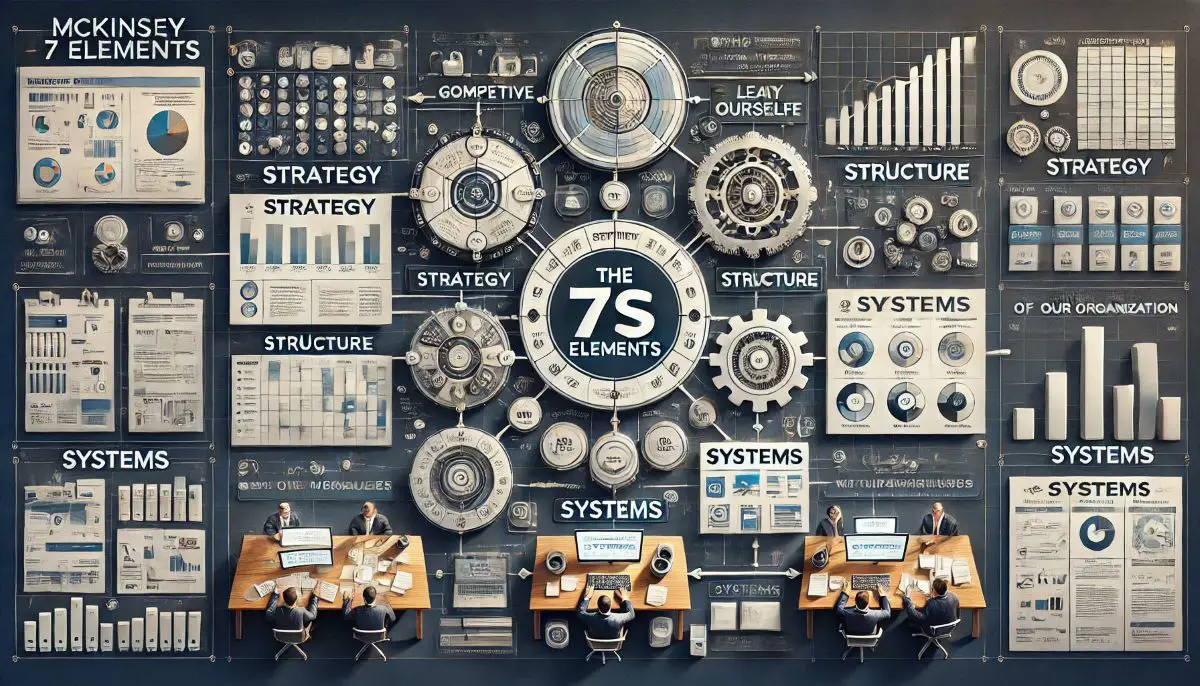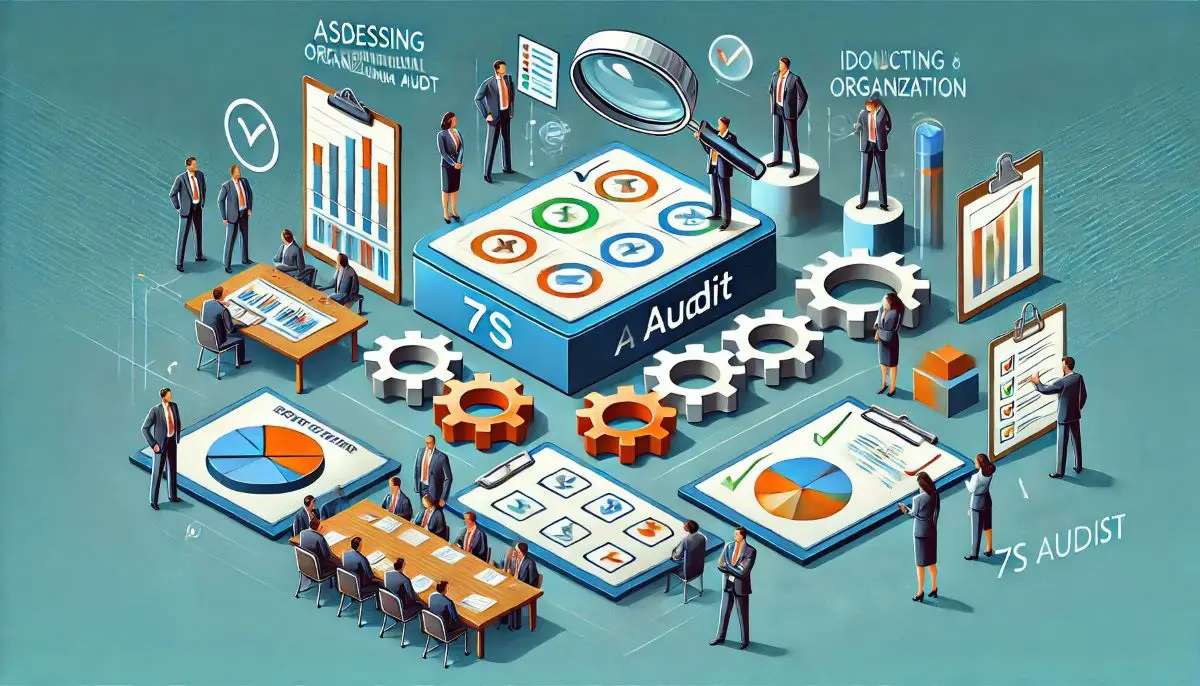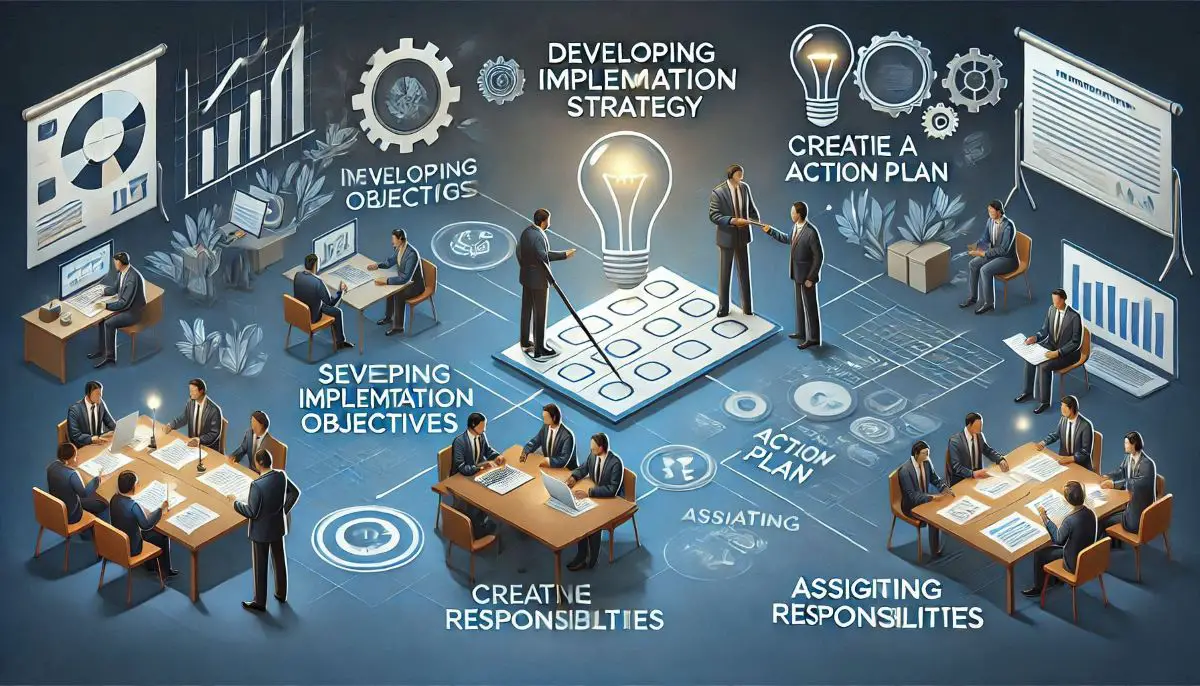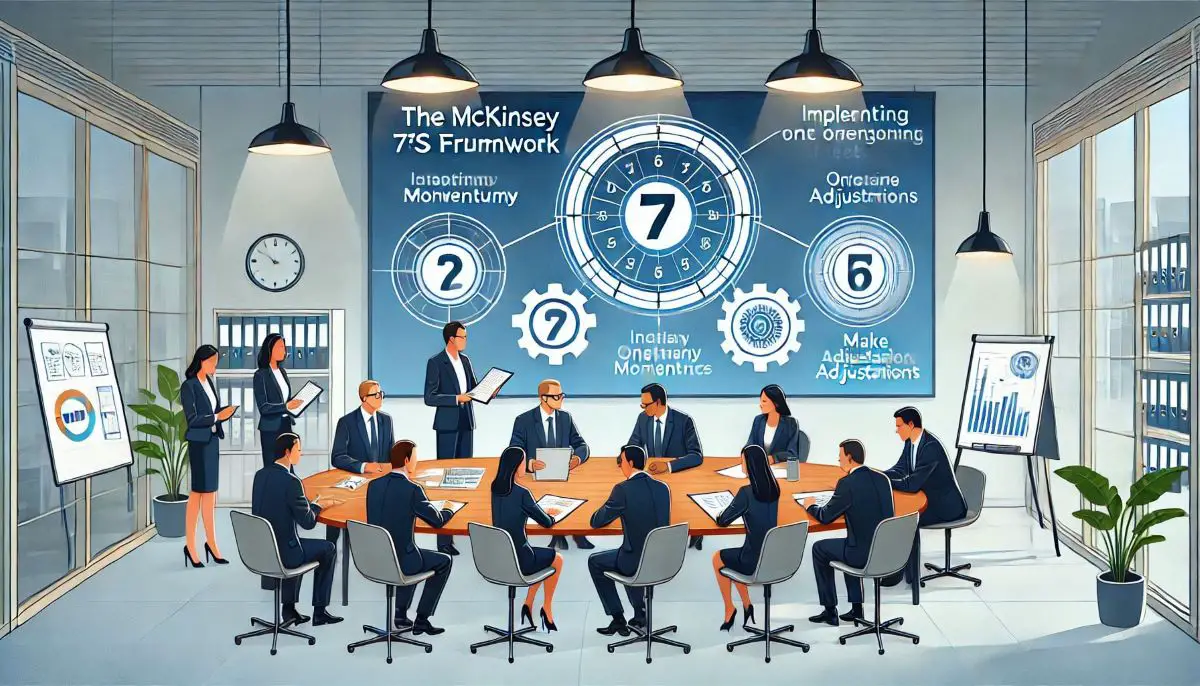In today’s fast-paced business world, we’re always on the lookout for tools to boost our organizational performance. That’s where the McKinsey 7S Framework comes in handy. This powerful model, developed by McKinsey & Company in the 1970s, gives us a structured approach to analyze and improve our business. It’s not just another management fad – it’s a time-tested method that’s helped countless companies navigate organizational change and strategic planning.
We’ll dive into how to put the McKinsey 7S model into action in your business. First, we’ll break down what the framework is all about and why it matters. Then, we’ll walk through the steps to size up your current situation, come up with a plan to implement the model, and keep tabs on your progress. By the end, you’ll have a solid grasp on using this framework to sharpen your leadership skills and drive your company’s success.
You can check our PowerPoint template for Harnessing the Power of the McKinsey 7S Framework for Optimal Organizational Efficiency.

Understanding the McKinsey 7S Framework
To implement the McKinsey 7S Framework effectively, we need to grasp its core components and how they work together. This powerful tool helps us analyze our organization‘s design and improve our performance. Let’s break down the key elements and see how they interact.
The 7 Elements
The McKinsey 7S Framework consists of seven crucial elements that shape our organization:
- Strategy: This is our game plan to stay competitive and achieve our goals. We need to make sure it’s clear, long-term, and aligns with our vision and values.
- Structure: It’s how we organize ourselves – who reports to whom and how we divide responsibilities. This forms the backbone of our company’s operations.
- Systems: These are the day-to-day procedures and workflows that keep our business running smoothly. They determine how we get things done.
- Shared Values: At the heart of our organization, these are the core beliefs and standards that guide our decisions and actions.
- Skills: These are the capabilities and competencies we have as a company. They determine what we can achieve and where we might need to improve.
- Style: This refers to our leadership approach and how we manage our team. It shapes our company culture and influences how we work together.
- Staff: This element covers all aspects of our human resources – from hiring and training to motivating and rewarding our team members.
Hard vs. Soft Elements
We can group these seven elements into two categories:
Hard Elements:
- Strategy
- Structure
- Systems
These are easier to identify and manage. They’re the more tangible aspects of our organization that we can directly control.
Soft Elements:
- Shared Values
- Skills
- Style
- Staff
These are less tangible and more influenced by our company culture. They can be harder to pin down but are just as crucial for our success.
Interconnectedness of the Elements
The key to the McKinsey 7S Framework is understanding that all these elements are interconnected. A change in one area will affect all the others. For example, if we decide to change our strategy, we might need to adjust our structure, develop new skills, or modify our systems to support that new direction.
This interconnectedness means we need to consider all seven elements when we’re planning changes or trying to improve our performance. We can’t just focus on one area and expect everything else to fall into place.
By using this framework, we can get a comprehensive view of our organization. It helps us identify where we’re strong and where we need to improve. It’s particularly useful when we’re going through big changes, like implementing a new strategy or restructuring our company.
Remember, there’s no one-size-fits-all approach. The key is to find the right balance among all seven elements that works best for our unique situation and goals. By aligning these elements, we can create a more effective and successful organization.

Assessing Your Current Organizational State
To implement the McKinsey 7S Framework effectively, we need to start by taking a close look at our current organizational state. This assessment helps us identify areas that need improvement and alignment. Let’s break down this process into three key steps.
Conducting a 7S Audit
We begin by conducting a thorough 7S audit. This involves examining each of the seven elements – strategy, structure, systems, shared values, skills, style, and staff – to understand how they currently function in our organization. We need to ask ourselves some critical questions about each element. For example, when looking at our strategy, we might ask: What’s the objective of our company strategy? How do we use our resources and capabilities to achieve that? What makes us stand out from our competitors? 1
Similarly, for structure, we should consider: What’s our organizational structure? Who makes the decisions? Is decision-making centralized or decentralized? How is information shared across the organization? 1
This audit gives us a comprehensive view of our current organizational design and helps us spot any inconsistencies or misalignments.
Identifying Gaps and Misalignments
Once we’ve completed our audit, the next step is to identify gaps and misalignments between the seven elements. We need to look for areas where our current practices don’t align with our overall strategy or where different elements are working against each other.
For instance, we might find that our structure doesn’t support our strategy, or our systems aren’t enabling the skills we need to develop. It’s crucial to create a list of these existing issues 2. This step helps us pinpoint where changes are needed to improve our organizational effectiveness.
SWOT Analysis
To complement our 7S assessment, we can also conduct a SWOT analysis. This tool helps us understand our strengths and weaknesses, and also creates a platform to assess opportunities available together with the threats that are outside our organization’s sphere 3.
By combining the insights from our 7S audit with a SWOT analysis, we get a more comprehensive picture of our current state. This allows us to identify not just internal misalignments, but also how our organization stands in relation to external factors.
Through this assessment process, we gain a clear understanding of where we are now. This sets the stage for determining where we want to be and how to get there using the McKinsey 7S Framework. Remember, the goal is to align all seven elements to support our strategy and improve our organizational performance.

Developing an Implementation Strategy
Now that we’ve assessed our current organizational state, it’s time to develop a strategy to implement the McKinsey 7S Framework. This process involves setting clear objectives, creating an action plan, and assigning responsibilities. Let’s break down each of these steps.
Setting Clear Objectives
To start, we need to identify the areas that aren’t effectively aligned within our organization. We’ll look for gaps and inconsistencies in the relationship between the seven elements of the framework. This step helps us determine what needs to change 4.
Next, we’ll work with top management to create an optimal organizational design. This involves setting realistic goals and achievable objectives that align with our strategy. It’s important to note that this step requires a lot of research and analysis, as there aren’t any one-size-fits-all templates to follow 4.
When setting our objectives, we should ask ourselves: “What do we need to change in each element so we can execute our strategy?” This question helps us focus on the specific changes needed in each area of the McKinsey 7S model 2.
Creating an Action Plan
With our objectives in place, we can now create a detailed action plan. This plan will outline the areas we want to realign and how we plan to do it 5. We’ll decide where and what changes should be made, which may involve adjusting the chain of hierarchy, communication flow, and reporting relationships 4.
Our action plan should include:
- Specific changes to be made in each of the seven elements
- Timelines for implementing these changes
- Key projects or initiatives to support our objectives
- Key Performance Indicators (KPIs) to measure progress
It’s crucial to co-create this plan with the team members who will be responsible for executing it. This collaborative approach helps ensure buy-in and maintains momentum throughout the implementation process 2.
Assigning Responsibilities
The success of our implementation strategy depends largely on the people involved in carrying it out. We need to find the right individuals within our company or hire consultants who are best suited to implement the changes 5.
When assigning responsibilities, consider:
- Who has the necessary skills and experience in change management?
- Who understands the different elements of the McKinsey 7S Framework?
- Who has the authority to make decisions and drive change in each area?
It’s important to create clear lines of accountability. Each person should understand their role in the implementation process and how their efforts contribute to the overall strategy 2.
Remember, implementing the McKinsey 7S Framework is an ongoing process. We’ll need to continuously review each area and make adjustments as needed. This helps us stay aligned with our strategy and respond to changes in the business environment 6.
By setting clear objectives, creating a detailed action plan, and assigning responsibilities, we’re setting ourselves up for success in implementing the McKinsey 7S Framework. This structured approach helps us align all seven elements of our organization, driving improved performance and achieving our strategic goals.

Monitoring and Adjusting the Implementation
After developing our implementation strategy for the McKinsey 7S Framework, we need to focus on monitoring progress and making necessary adjustments. This ongoing process is crucial to ensure our organization stays aligned with our strategic goals and adapts to changes in the business environment.
Key Performance Indicators
To effectively monitor our implementation, we need to establish clear Key Performance Indicators (KPIs). These metrics help us measure the success of our initiatives and track our progress towards our strategic objectives. We should define KPIs for each of the seven elements of the framework, ensuring they align with our overall strategy.
For example, if we’re focusing on improving our systems, we might track metrics related to efficiency, error rates, or system downtime 7. It’s important to review these KPIs regularly and use them to guide our decision-making process.
Regular Review Meetings
Implementing the McKinsey 7S Framework isn’t a one-time event; it requires ongoing attention and adjustment. To maintain momentum and ensure we’re on track, we need to hold regular review meetings. These meetings serve as checkpoints to assess our progress, identify challenges, and make necessary adjustments to our implementation plan.
During these meetings, we should review the performance of our teams and projects to ensure our organization remains aligned with our strategic goals 2. It’s crucial to involve key stakeholders in these discussions, including decision-makers and those responsible for executing the changes.
Continuous Improvement
The final aspect of monitoring and adjusting our implementation is embracing a mindset of continuous improvement. We need to be open to changing our plans and approach as we progress. Using insights, knowledge, and new information to improve our strategy is essential for long-term success 2.
As part of this process, we should periodically reassess each of the seven elements and their alignments. This helps us keep up with changes in the business environment and ensure our organization remains agile and responsive 6.
For instance, we might need to reorganize our staff deployment or invest in reskilling our employees to adapt to new technologies or market demands. These are just some examples of the remedial actions we might undertake in our ongoing review process 6.
By focusing on these three key areas – setting and tracking KPIs, holding regular review meetings, and embracing continuous improvement – we can effectively monitor and adjust our implementation of the McKinsey 7S Framework. This approach helps us maintain alignment across all seven elements of our organization, driving improved performance and achieving our strategic goals in the long run.

Conclusion
The McKinsey 7S Framework has a significant impact on organizational effectiveness and strategic alignment. By focusing on the seven key elements – strategy, structure, systems, shared values, skills, style, and staff – businesses can create a more cohesive and high-performing environment. This approach allows companies to identify gaps, make necessary adjustments, and ensure all aspects of the organization work together to achieve common goals.
To put the McKinsey 7S Framework into action, it’s crucial to start with a thorough assessment, develop a clear implementation strategy, and continuously monitor progress. This ongoing process helps businesses stay agile and responsive to changes in the market. By embracing this framework, companies can boost their performance, foster innovation, and set themselves up for long-term success in today’s competitive business landscape.
FAQs
How can the McKinsey 7S Model be applied within a company?
To apply the McKinsey 7S Model in a business, follow these steps:
- Review the current organizational design to understand existing structures and processes.
- Define the optimal organizational blueprint that aligns with your business goals.
- Identify necessary realignments to ensure all elements of the model work cohesively.
- Implement the action plan with clear steps and timelines.
- Conduct regular reviews to monitor progress and make adjustments as needed.
What steps are involved in implementing the 7S framework in a workplace setting?
Implementing the 7S framework in the workplace involves several key steps:
- Sort: Organize and prioritize workplace items and processes.
- Set in Order: Arrange everything in a logical order to streamline operations.
- Shine: Maintain and clean the workplace to ensure it is always ready.
- Standardize: Develop standard operating procedures for consistency.
- Sustain: Keep up the established practices and continue to improve.
- Spirit: Foster a positive workplace culture and team spirit.
- Safety: Ensure a safe working environment for all employees.
Can you provide an example of a company that has successfully used the McKinsey 7S Model?
Pepsi is a notable example of a company that has successfully implemented the McKinsey 7S Model. Originally established in 1983, Pepsi has grown to become the world’s second most valuable soft drink brand, largely due to its strategic organizational structure based on the 7S framework.
What role does the McKinsey 7S Framework play in corporate planning and policy?
The McKinsey 7S Framework is crucial for optimizing organizational design by analyzing seven essential elements: strategy, structure, systems, shared values, skills, style, and staff. This comprehensive approach helps in aligning corporate policies and planning with the overall strategic goals of the organization.
Looking for Premium maps, please visit our affiliate site: https://editablemaps.com/ or https://ofomaps.com/
References
[1] – https://creately.com/blog/strategy-and-planning/mckinsey-7s-model-guide/
[2] – https://www.cascade.app/blog/mckinsey-7s-model
[3] – https://www.researchgate.net/publication/342481317_Utilizing_Mckinsey_7s_Model_SWOT_Analysis_PESTLE_and_Balance_Scorecard_to_Foster_Efficient_Implementation_of_Organizational_Strategy_Evidence_from_The_Community_Hospital_Group-Ghana_Limited
[4] – https://corporatefinanceinstitute.com/resources/management/mckinsey-7s-model/
[5] – https://strategicmanagementinsight.com/tools/mckinsey-7s-model-framework/
[6] – https://www.soundingboardinc.com/blog/understand-mckinsey-7s-model/
[7] – https://www.stratnavapp.com/Articles/McKinsey-7S














